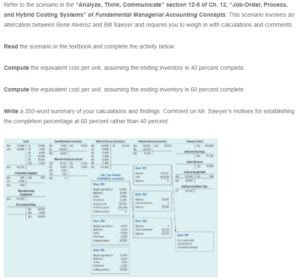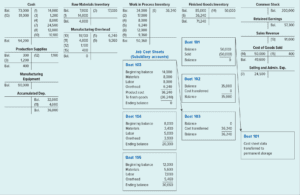Analyze, Think, Communicate
Calculation of Equivalent Cost per Unit Assuming a 40% Completion of Ending Inventory
- 94,500 + 5,500 = 100,000 W.I.P
- 100,000 – 90,000 = 10,000
- 90,000 × 100% = 90,000
- 10,000 × 40% = 4,000
- 10,000 + 90,000 = 100,000
- 100,000 + 4,000 = 104,000
- 90,000 – 40,000 = 86,000
- 902,400 ÷ 86,000 = $10.49 cost per unit
- 90,000 × $10.49 = $944,100
- 4,000 × $10.49 = $41,960
$944,100 + $41,960 = 986,060
Calculation of Equivalent Cost per Unit Assuming A 40% Completion of Ending Inventory
- 94,500 + 5,500 = 100,000 W.I.P
- 100,000 -90,000 = 10,000
- 90,000 × 100% = 90,000
- 10,000 × 60% = 6,000
- 90,000 + 6,000 = 96,000
- $902,400 ÷ 96,000 = $9.4 cost per unit
- 90,000 × $9.4 = 846,000
- 6,000 × $9.4 = $56,400
$846,000 + $56,400 = $902,400
Do you need help with your assignment? Feel free to contact us. Our team of experts is ready to help.
Summary of Calculations and Findings
As presented in the case scenario, Mr. Sawyer has more experience than Ms. Alverez (Edmonds et al., 2011). The findings presented by Ms. Alverez are misleading because they are wrong. The argument postulated by Mr. Sawyer is valid and correct because Ms. Alverez gave no proof for her findings. Additionally, Mr. Sawyer can be trusted because of his ability to control costs and their value in the plant. Therefore, Ms. Alverez needed to find a way to prove whether her findings were right or wrong, and in the meantime, she should accept and recognize Mr. Sawyer’s win.
The equivalent cost per unit calculation is presented above for 40% and 60% completion in inventory. The calculations vindicate the assertions made by Mr. Sawyer. In the calculations, Mr. Sawyer added the beginning balance of 5,500, and the work started in the period was 94,500, totaling 100,000 units. A total of 10,000 units were left in work in progress, while a total of 90,000 units were completed and transferred to the finished goods. The calculations are in line with the one above.
Further, Mr. Sawyer multiplied the 90,000 units by 100%, which still resulted in 90,000 units. The 10,000 incomplete units were multiplied by 60%, resulting in 6,000 equivalent units. The 6,000 units were added to the completed 90,000 units, resulting in 96,000 equivalent units. The units are divided by the total expense of $902,400; the final result was $9.4 comparable cost per unit.
To verify the findings, Mr. Sawyer multiplied the $9.4 equivalent cost per unit by the finished goods balance of 90,000. The result of the multiplication was $846,000. The same was repeated for the work-in-progress equivalent units by multiplying 6,000 units with a $9.4 comparable cost per unit, which resulted in $56,400. Adding the two ($846,000 + $56,400 = $902,400) resulted in a figure similar to the expense costs, thus verifying the workings. Mr. Sawyer’s motive for establishing the completion percentage at 60% instead of 40% was the aspiration of promotion to plant manager in the following year. The calculations had to be true if he was fit to be promoted to a plant manager role, and he could lose the promotion to Ms. Alverez if the calculations were wrong. Ms. Alverez should work alongside Mr. Sawyer to learn more and become better.
Reference
Edmonds, T., Tsay, B., & Olds, P. (2011). Fundamental Managerial Accounting Concepts (6th ed.). McGraw-Hill/Irwin.
ORDER A PLAGIARISM-FREE PAPER HERE
We’ll write everything from scratch
Question

Analyze, Think, Communicate
Refer to the scenario in the “Analyze, Think, Communicate” section 12-5 of Ch. 12, “Job-Order, Process, and Hybrid Costing Systems” of Fundamental Managerial Accounting Concepts. This scenario involves an altercation between Rene Alverez and Bill Sawyer and requires you to weigh in with calculations and comments.
Read the scenario in the textbook and complete the activity below.
Compute the equivalent cost per unit, assuming the ending inventory is 40 percent complete.
Compute the equivalent cost per unit, assuming the ending inventory is 60 percent complete.
Write a 350-word summary of your calculations and findings. Comment on Mr. Sawyer’s motives for establishing the completion percentage at 60 percent rather than 40 percent.


